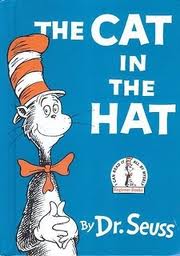Dr. Seuss
April 23, 2011
Dr. Seuss has long been a favorite author of mine. His books were some of the first that I was able to read independently . The Sneetches, Green Eggs and Ham, and Horton Hatches an Egg were my favorites as a child.
Even as a child, The Cat in the Hat was questionable to me. I wasn’t sure whether I liked this feline character or not. Although he had great, imaginative ideas for the children in the story, I couldn’t help but think he was trying to use peer pressure to persuade them to do things that their mother most certainly wouldn’t approve of. The fish seemed more like a friend to the children than the cat. I think the cat represents that feeling in all of us – the one that makes us want to do something that we know we shouldn’t do…things that sound like fun, but will most likely result in us getting into trouble. The fish, on the other hand, represents our conscience or a good friend that has our best interest at heart – a character that knows it is always best to follow the rules and do the right thing rather than follow the crowd or be badly influenced.
The tension presented in The Cat in the Hat reminds me of only one other story in which I am familiar, and it is not really a contemporary children’s book. Walt Disney’s Pinocchio reminds of The Cat in the Hat in several ways. First of all, Pinocchio gets into trouble when he is away from his father. (The children find themselves in a predicament with the cat when their mother is out.) Pinocchio knows the right thing to do, and is encouraged to make good decisions by Jiminy Cricket. (The children know to follow their mother’s rules and are encouraged to make the right decisions by the fish.) Although there are several other books that have tension in the plot, I think The Cat in the Hat and Pinocchio are more closely related than any other.
The Cat in the Hat, although published in 1957, still appeals to children today. Regardless of the age of this story, it remains an easy read for beginning readers, and the Cat is one of the most famous storybook characters of all time.
The Lorax is a story that I simply do not recall reading at any time during my childhood. I’m not really sure how I would have felt about this book when I was younger, but as an adult I am a huge fan. The Lorax is extremely didactic. The story begins with a boy who wants to hear the story of the Lorax. He must pay to hear this tale, which is told from the Once-ler’s point of view – a character who got caught up in his business of cutting down Truffula trees. The Once-ler tells of his selfishness and greed and how his success took precedence over the ecosystems supported by this rare tree. As a result, he destroys the once beautiful piece of land on which his business stood, where the Truffula trees prospered, and nothing is left now except for darkness and emptiness – a very lonely, desolate piece of property and one last remaining thought from the Lorax – the word “UNLESS” carved into a rock. The Lorax, who tried to warn the Once-ler all along of what would happen if he did not “slow down” with his business seems to almost haunt the Once-ler throughout the story. The Once-ler recalls his warnings but has no idea where the Lorax is now, and he seemingly regrets what he did to what was once such a beautiful place in the world. In fact, he never shows his face at all in the story as though he is too ashamed to even be seen. The story does not end happily, as the damage has already been done, and obviously, one cannot change the past. However, the last pages of the book encourage readers to protect the environment and be aware of what could happen to our world if we do not take care of what we have been given. We can make a difference and sometimes we are even lucky enough to repair damage that has been done if we only take the initiative and make nature a priority. Thus, the Once-ler gives the boy the very last Truffula tree seed in hopes that he might somehow be able to recreate the paradise that once existed, and perhaps even the Lorax might someday return.
There are few children’s books today that are didactic, in my opinion. I can think of very few that teach a lesson quite like The Lorax does. The few books that I can think of include Zen Shorts, Zen Ties, and the much older, Aesop’s Fables. These books offer morals and make readers think about the choices they make.
Images obtained from http://www.kids-bookreview.com, http://www.seuss.wikia.com, and http://www.blog.amnestyusa.com


